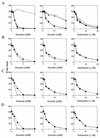The ars operon in the skin element of Bacillus subtilis confers resistance to arsenate and arsenite
- PMID: 9537360
- PMCID: PMC107075
- DOI: 10.1128/JB.180.7.1655-1661.1998
The ars operon in the skin element of Bacillus subtilis confers resistance to arsenate and arsenite
Abstract
The Bacillus subtilis skin element confers resistance to arsenate and arsenite. The ars operon in the skin element contains four genes in the order arsR, ORF2, arsB, and arsC. Three of these genes are homologous to the arsR, arsB, and arsC genes from the staphylococcal plasmid pI258, while no homologs of ORF2 have been found. Inactivation of arsR, arsB, or arsC results in either constitutive expression of ars, an arsenite- and arsenate-sensitive phenotype, or an arsenate-sensitive phenotype, respectively. These results suggest that ArsR, ArsB, and ArsC function as a negative regulator, a membrane-associated protein need for extrusion of arsenite, and arsenate reductase, respectively. Expression of the ars operon was induced by arsenate, arsenite, and antimonite. Northern hybridization and primer extension analysis showed that synthesis of a full-length ars transcript of about 2.4 kb was induced by arsenate and that the ars promoter contains sequences that resemble the -10 and -35 regions of promoters that are recognized by E sigmaA.
Figures





Similar articles
-
Regulation and expression of the arsenic resistance operon from Staphylococcus aureus plasmid pI258.J Bacteriol. 1992 Jun;174(11):3684-94. doi: 10.1128/jb.174.11.3684-3694.1992. J Bacteriol. 1992. PMID: 1534328 Free PMC article.
-
Expression and regulation of the antimonite, arsenite, and arsenate resistance operon of Staphylococcus xylosus plasmid pSX267.J Bacteriol. 1992 Jun;174(11):3676-83. doi: 10.1128/jb.174.11.3676-3683.1992. J Bacteriol. 1992. PMID: 1534327 Free PMC article.
-
The ars operon of Escherichia coli confers arsenical and antimonial resistance.J Bacteriol. 1995 Feb;177(4):981-6. doi: 10.1128/jb.177.4.981-986.1995. J Bacteriol. 1995. PMID: 7860609 Free PMC article.
-
Plasmid-encoded resistance to arsenic and antimony.Plasmid. 1992 Jan;27(1):29-40. doi: 10.1016/0147-619x(92)90004-t. Plasmid. 1992. PMID: 1531541 Review.
-
Mechanisms of metalloregulation of an anion-translocating ATPase.J Bioenerg Biomembr. 1995 Feb;27(1):85-91. doi: 10.1007/BF02110335. J Bioenerg Biomembr. 1995. PMID: 7629056 Review.
Cited by
-
Differentiation of regions with atypical oligonucleotide composition in bacterial genomes.BMC Bioinformatics. 2005 Oct 14;6:251. doi: 10.1186/1471-2105-6-251. BMC Bioinformatics. 2005. PMID: 16225667 Free PMC article.
-
The chromosomal arsenic resistance genes of Thiobacillus ferrooxidans have an unusual arrangement and confer increased arsenic and antimony resistance to Escherichia coli.Appl Environ Microbiol. 2000 May;66(5):1826-33. doi: 10.1128/AEM.66.5.1826-1833.2000. Appl Environ Microbiol. 2000. PMID: 10788346 Free PMC article.
-
Biochemical, molecular and in silico characterization of arsenate reductase from Bacillus thuringiensis KPWP1 tolerant to salt, arsenic and a wide range of pH.Arch Microbiol. 2021 Dec 21;204(1):46. doi: 10.1007/s00203-021-02660-5. Arch Microbiol. 2021. PMID: 34932145
-
Design of a Whole-Cell Biosensor Based on Bacillus subtilis Spores and the Green Fluorescent Protein To Monitor Arsenic.Microbiol Spectr. 2023 Aug 17;11(4):e0043223. doi: 10.1128/spectrum.00432-23. Epub 2023 Jun 7. Microbiol Spectr. 2023. PMID: 37284752 Free PMC article.
-
Use of Microbial Consortia in Bioremediation of Metalloid Polluted Environments.Microorganisms. 2023 Mar 30;11(4):891. doi: 10.3390/microorganisms11040891. Microorganisms. 2023. PMID: 37110315 Free PMC article. Review.
References
-
- Adams A, Oishi M. Genetic properties of arsenate-sensitive mutants of Bacillus subtilis 168. Mol Gen Genet. 1972;118:295–310. - PubMed
-
- Asai, K. Personal communication.
-
- Bobrowicz P, Wysocki R, Owsianik G, Goffeau A, Ulaszewski S. Isolation of three contiguous genes, ACR1, ACR2 and ACR3, involved in resistance to arsenic compounds in the yeast Saccharomyces crevisiae. Yeast. 1997;13:819–828. - PubMed
-
- Bruhn D F, Li J, Silver S, Roberto F, Rosen B P. The arsenical resistance operon of IncN plasmid R46. FEMS Microbiol Lett. 1996;139:149–153. - PubMed
Publication types
MeSH terms
Substances
LinkOut - more resources
Full Text Sources
Other Literature Sources
Molecular Biology Databases

